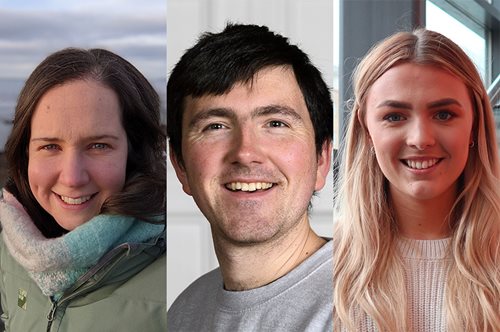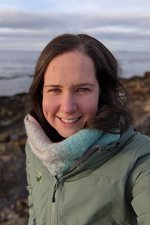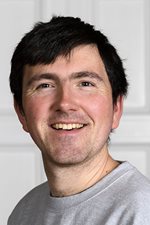Past William Guy Lecturers
Beginning in 2023, the William Guy Lectureship moved from being in-person to being online-first, with lecturers recording talks as well as being available for in-person or live online sessions. Explore past recorded talks below. If you would like to contact a past lecturer, please email policy@rss.org.uk.
William Guy Lecturers 2023-2024
For the 2023-24 academic year the theme was Climate change and environmental statistics. Find out more about the 2023-24 William Guy Lecturers and watch their talks below.

- Katherine Whyte, environmental statistician at Biomathematics and Statistics Scotland (BioSS), Edinburgh/Fife, William Guy Lecturer 2023-2024 for ages 5–11 – When we build wind farms, what happens to the wildlife?
- Craig Anderson, senior lecturer in statistics, University of Glasgow, Scotland, William Guy Lecturer 2023-2024 for ages 11–16 – Using statistics to monitor air pollution
- Eleanor D’Arcy, PhD student in statistics, Lancaster University, William Guy Lecturer 2023-2024 for age 16+ – How can statistics protect us against extreme sea levels resulting from climate change?
Katherine Whyte – William Guy Lecturer 2023-2024 for ages 5–11
 About Katherine
About Katherine
Katherine is an environmental statistician at Biomathematics and Statistics Scotland (BioSS). In her work at BioSS, she researches the interactions between offshore renewable energy developments and marine wildlife such as seals and seabirds. She is an active STEM (Science, Technology, Engineering and Mathematics) ambassador, and has experience in delivering talks and activities with both school pupils and the general public. Katherine is based in Edinburgh/Fife.
Katherine’s talk: When we build wind farms, what happens to the wildlife?
To combat climate change, countries across the world are racing to create more of their energy from renewable sources like wind energy. Wind farms are now a regular sight all along the coast of Britain. But when we build wind farms, what happens to the wildlife that lives there?
In this interactive talk, I will look at how we can use maths and statistics to help us balance the benefits of wind energy with the risks posed to ocean wildlife like seals and seabirds. Where were the animals before we built the wind farm, and how many were there? How many animals leave when a wind farm is built, and do they come back? What do animals do when they are near a wind farm, and can they still find enough food in the sea?
Statistics is an important tool in helping us to answer these questions, and helping us make decisions that are both good for the planet and good for our local wildlife.
This video is made up of 3 sections to accommodate different teaching opportunities. The entire video can be watched in one sitting. Alternatively, Section 1 can be watched as a stand-alone video, with optional follow-up Sections 2 and 3.
- Section 1: When we build wind farms, what happens to the wildlife? (~ 6 minutes) This section introduces the challenge of balancing renewable energy with looking after our oceans, and highlights the importance of maths and statistics in helping us achieve both goals.
- Section 2: What might happen to wildlife? (~5 minutes) This section takes a more detailed look at how building a wind farm may change the environment and wildlife living there, and the role of maths and statistics in understanding this.
- Section 3: How do we decide if we should build a wind farm? (~2 minutes) This final section explores the role of maths and statistics in deciding where, when, and if a wind farm should be built.
Craig Anderson – William Guy Lecturer 2023-2024 for ages 11–16
 About Craig
About Craig
Craig is a senior lecturer in statistics at the University of Glasgow. Craig carries out research in health and environmental statistics, including work on estimating and mapping air pollution levels and understanding geographical health inequalities. Craig has extensive experience with public outreach activities, including delivering lectures and workshops within schools to a variety of age groups. Craig is particularly keen to show children how they can get involved in mathematics and statistics, and his talk includes an element of citizen science which allows children to participate in their own research.
Craig’s talk: Using statistics to monitor air pollution
Around 30,000 deaths per year in the UK are linked to air pollution according to government figures. Air pollution has been shown to contribute to diseases such as coronary heart disease, stroke, respiratory disease and lung cancer. Around the UK, governments and local authorities are increasingly taking action to reduce air pollution levels through schemes which reduce vehicle emissions and encourage the use of public transport, cycling and walking.
To target these interventions in the right areas, it is crucial that we can understand which parts of the country are most exposed to pollutants. There are around 500 monitoring stations across the UK which regularly measure pollution levels. The data from these stations can be used to help us understand where and when the highest levels of pollution occur.
This talk will explain how statistics is at the heart of this process. It will explore how statistical methods are used to determine how many monitoring stations are needed and where to place them around the country. It also discusses the surprisingly simple ideas behind the statistical models which are used to estimate pollution levels throughout the UK, including in areas which have no monitoring stations. The talk concludes with a discussion of citizen science, and how data collected by small monitors at schools might hold the key to further reducing pollution and saving lives across the country.
Eleanor D’Arcy - William Guy Lecturer 2023-2024 for ages 16+
 About Eleanor
About Eleanor
Eleanor is a PhD student in statistics at Lancaster University. She is actively involved in a schools engagement programme, visiting secondary schools and sixth form colleges in the North West. She is particularly interested in scientific communication; Eleanor recently won a national competition for communicating research on the industrial stage and last year was a finalist in another competition where she presented her work at the House of Commons. As a women in STEM, she aims to challenge school students’ preconceptions on what it means to be a mathematician and hopes to pave an easier path for the next generation of underrepresented mathematicians.
Eleanor’s talk: How can statistics protect us against extreme sea levels resulting from climate change?
Sea level rise and changes in weather conditions due to climate change have increased the risk of coastal flooding. It is increasingly important that we can accurately estimate sea levels to determine how high we need to build coastal defences such as sea walls.
Extreme sea levels that pose a threat to coastline communities have not yet been observed. We therefore need to predict levels beyond the range of observed data, which requires statistical modelling. Overestimation results in wasted resources but underestimation can lead to defences being breached, with devasting consequences including loss of life and damage to infrastructure.
In this talk, I will discuss the importance of statistically modelling extreme events and demonstrate how this is fundamental in our fight against climate change. Using my sea level model as an example, I will present some of the statistical techniques I use that stem from topics you will have covered at school, including linear regression, correlation, and statistical distributions. I will explain how my results will be used for upgrading coastal defences nationwide, to highlight the significance of statistical research in the real world.